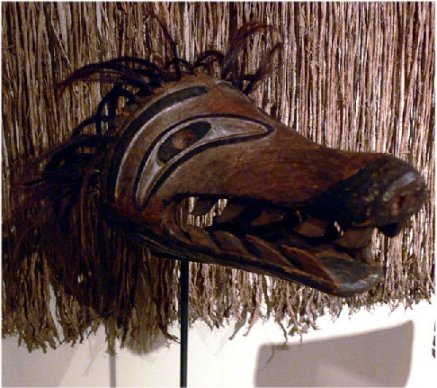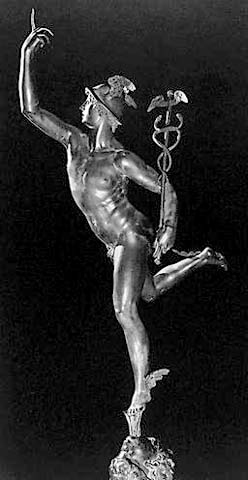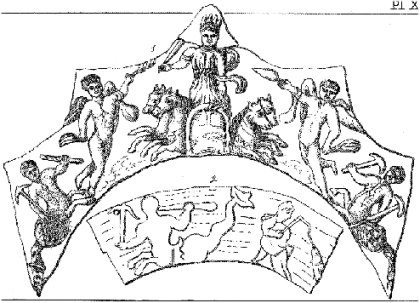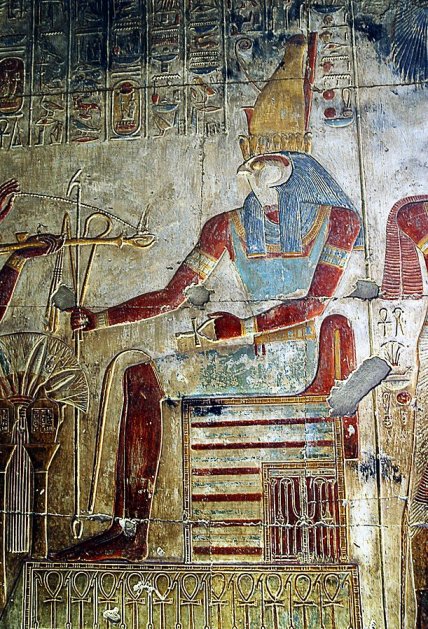Indigenous Myths and
the Nummo Ancestors
Updated May, 2023
 Nuu-chah-nulth Wolf MaskWolf's mask with sharp teeth, from Nootka Sound; North America department, Ethnological Museum, Berlin, Germany (allegedly by James Cook and his crew;) http://commons.wikimedia.org/wiki/File: Wolf_mask_1_Nootka_Sound_EthnM.jpg |
A story called, Two Brothers Who Changed Things, was told by Indigenous Peoples living in Washington State in the US, and on Vancouver Island in British Columbia, Canada. I believe this story came from the Nuu-chah-nulth people who lived in those areas. One aspect of this mythic tale that is particularly relevant to the Dogon religion, is the fact that the story tells of two brothers who were responsible for changing things on the Earth.http://www.ilhawaii.net/ ~stony/lore43.html
According to the Indigenous North American myth, "When the world was very young, there were no people on the Earth. There were no birds or animals, either. There was nothing but grass and sand and creatures that were neither animals nor people but had some of the traits of people and some of the traits of animals... The Two-Men-Who-Changed-Things called all the creatures to them. Some they changed to animals and birds and some they changed to trees and smaller plants."http://www.ilhawaii.net/ ~stony/lore43.html
I believe that the two brothers from the Indigenous North American myth are the same two brothers referred to in the Dogon religion, who were known as the First and Second Ancestors. Like all of the Eight Ancestors, the First and Second Ancestors were part human and part Nummo. The sun symbolized the immortal Nummo in the Dogon religion and the moon was a symbol of humans and the Earth.
In the Indigenous North American myth, the two brothers were the children of the sun and the moon. To the Dogon this would have meant that the brothers in the Indigenous American story were hybrids, being part Nummo and part Human. Shannon Dorey, Day of the Fish p. 37.
In the Dogon religion, the Second Ancestor was identified with the Jackal or Fox and was associated with humans losing their immortality. The Jackal was identified with the fox, dog and wolf in various ancient cultures and associated with death.
The event that caused humans to lose their immoraltiy was the result of a failed experiment.Shannon Dorey, Day of the Fish p. 35. This changing of things on the Earth in the Indigenous North American myth sounds like a manipulation of the DNA existing on the Earth at the time. According to the Dogon, when the experiment occurred, the DNA of all the animals and plants was changed to coincide with the changes made in human DNA.
Because the experiment caused humans to lose their immortality, the Dogon associated the DNA that changed things with something that was stolen from the Earth. It was associated with stolen fire. DNA was also symbolized by grain and associated with stolen seed.
In The Master (Mistress) of Speech, I refer to the mythology of the Quinault people of North America and the Awonawilona of the Pueblo Zuni of the Southwestern U.S.
In the Quinault tribes of North America, the changer god Kwatee changed things to prepare the world for the humans he was to make from his own sweat and from dogs, lizards and other small creatures. At the start of creation, the ant, beaver, coyote, fox, hawk, salmon, spider, and others tenanted the Earth. Kwatee cut them down to size, making smaller replicas of them to make room for humans.
This story reminds us of the same one Ogotemmêli told Griaule when he said, that before the descent of the celestial granary, which was the Nummo spaceship,"there were only a few animals such as the ant, the termite, the jackal, and perhaps also the scorpion and the sun lizard." It is also interesting that the Quinault said Kwatee created other people from his own sweat and from animals. This suggests he combined his own essence with that of the animals of the Earth, just as the Nummo Ancestors did. The reference to sweat is also important, as it symbolizes water and the life force in the Dogon religion..
Another story of the creation of the first humans appeared in the mythology of Awonawilona of the Pueblo Zuni of the Southwestern U.S., in which there were references to the primeval sea, the Earth mother, and the sky father. In that story, humans were born from four wombs stirring with the seeds of life in the Earth. Inside each womb lied unfinished creatures that were writhing like reptiles. There was also a reference to the divine twins who freed the creatures from the wombs and instructed the living things on how to make themselves ready for birth.
They led them out to the light, but there were "numerous casualties since some fell back and only escaped later" with deformities, and some that were physically and mentally challenged. The story told of how the first humans reacted strangely when they reached the light. Having been adapted to the womb world, they "possessed scales, short tails, owl's eyes, huge ears, and webbed feet." They greeted the first sunrise in howling terror. Their adjustment to life on the surface of the Earth was gradual and the medicine man, Yanaulaha, contributed greatly to this difficult process..
References to divine twins, to the place of generation as wombs in the Earth, and to the twins instructing creatures how to make themselves ready for birth all recall Dogon mythology. The Zuni twins seem to use the same process described by Ogotemmêli when the Nummo twins spoke the instruction while the regeneration was occurring. The description of these fetal creatures as having "owl eyes, tails, scales and webbed feet" also relates to descriptions of the Nummo hybrids mentioned by Ogotemmêli...Shannon Dorey, The Master of Speech Elemental Expressions Ltd. 2013 pp. 242-243.
According to the Dogon, the Nummo lived underground and in caves and came out at night suggesting that the sunlight bothered them.Shannon Dorey, The Master of Speech Elemental Expressions Ltd. 2013 p. 18.
In The Nummo, I refer to the Cherokee, another Indigenous North American people, who also have a story relating to the Jackal and the stolen fire. The Cherokee identified the Milky Way as "Where the Dog Ran." According to Cherokee tradition, "the `people in the south had a corn mill' from which meal was stolen again and again. In due course the owners discovered the thief, a dog, who `ran off howling to his home in the North, with the meal dropping from his mouth as he ran, and leaving behind a white trail where now we see the Milky Way, which the Cherokee call to this day. `Where the Dog Ran'". The identification of the trail with the Milky Way suggests that the dog travelled through space, relating it to the Jackal and the stolen spaceship or granary. Shannon Dorey, The Nummo pp. 189.
I believe that corn played a similar role in Indigenous North American mythology to that of grain in Dogon mythology. It represented DNA. The colour white relates to the trail left behind and is the colour that symbolized the Jackal in the Dogon religion.
The Jackal was identified with the fox, dog, hyena and wolf in the Dogon religion. This North American Nuu-chah-nulth Wolf Mask, which resides in the Ethnological Museum, Berlin, Germany, shown at top, was allegedly acquired by James Cook and his crew from Nootka Sound, British Columbia, Canada in 1778. The mask suggests that the dog also played a significant role in the myths of the Nuu-chah-nulth.North America department, Ethnological Museum, Berlin, Germany (allegedly by James Cook and his crew;)
http://commons.wikimedia.org/wiki/File: Wolf_mask_1_Nootka_Sound_EthnM.jpg
Stealing appears in many world myths, which I believe originated from the Dogon story about the Jackal, the two brothers and the stolen fire. The Greek god Hermes is the god of thieves in Greek mythology. The caduceus he carries looks like DNA, which I believe symbolizes the stolen DNA.
Hermes was depicted with wings on his sandals. Hermes was also the first to light a fire, and fire symbolizes the stolen DNA in the Dogon religion. In the Greek myth, Hermes also stole fifty immortal cows from the sun god Apollo. Both the sun and the cow were symbols of the Nummo in the Dogon religion. Once again they symbolize the stolen DNA, which was associated with the Nummo. Shannon Dorey, The Nummo p. 74.
 Winged Hermes With Caduceus, by Giovanni Bologna 1580Hermes by Giovanni Bologna from 1580 |
According to Robert Graves, "It is likely that the eagle-wings on Hermes sandal were originally not a symbol of swiftness but a sign of the holiness of the heel, and so, paradoxically a symbol of lameness." All of the Eight Nummo Ancestors had fish tails like the Nummo. They were hermaphrodites but looked like mermaids and mermen with human upper bodies and fish tailed lower bodies. Because they didn't have two legs like humans, the Dogon people perceived the Nummo and the Nummo Ancestors as being physically challenged. They had special devices that helped them fly over the land because of their inability to move quickly on land.Shannon Dorey, The Master of Speech p.116.
In the Indigenous North American myth about the two brothers, the one individual who was "a bad thief" was turned into a seal. The second thief, who was both a fisherman and a thief, had stolen a necklace of shells. This necklace of shells may have been made of cowry shells, which also symbolized DNA in the Dogon religion. The stolen necklace likely symbolized the stolen DNA. Cowry shells were used as currency in the Dogon culture because of their association with DNA.
The Nummo Ancestors were hermaphrodites and because of this characteristic they were considered twins. Trade began with twins because they had the same genetic makeup or the same value, which is how cowries, which symbolized DNA became associated with currency. It was because of this association with the Nummo Ancestors that humans twins were so revered in the Dogon culture.Shannon Dorey, The Master of Speech pp.185-187.
The Dogon were not the only group of people to use cowries for currency. In Day of the Fish, I refer to cowries being used in many places of the world, including India and China, where over three thousand years ago, cowry shells, or copies of the shells, were used as currency. The Ojibway, another Indigenous people of North America, also used cowry shells.
...which they called sacred Megis Shells or Whiteshells in Midewiwin ceremonies, and the Whiteshell Provincial Park in Manitoba, Canada is named after this type of shell. There is some debate about how the Ojibway traded for or found these shells, so far inland and so far north, very distant from the natural habitat. Oral stories and birch bark scrolls seem to indicate that the shells were found in the ground, or washed up on the shores of lakes or rivers. Finding the cowry shells so far inland could indicate the previous use of them by an earlier group in the area, who may have obtained them through an extensive trade network in the ancient past. Petroforms in the Whiteshell Provincial Park may be as old as 8,000 years.Shannon Dorey, Day of the Fish p.115.
The significance of twins is also found in many ancient cultures including some North American Indigenous peoples of British Columbia and referred to in Day of the Fish. Frazer refers to it in The Golden Bough.
This curious superstition prevails among some of the [Indigenous Peoples] of British Columbia, and has led them often to impose certain singular restrictions or taboos on the parents of twins, though the exact meaning of these restrictions is generally obscure. Thus the Tsimshian of British Columbia believe that twins control the weather; therefore they pray to wind and rain, "Calm down, breath of the twins." Further, they think that the wishes of twins are always fulfilled; hence twins are feared, because they can harm the man [human] they hate. They can also call the salmon and the olachen or candle-fish, and so they are known by a name which means "making plentiful." In the opinion of the Kwakiutl of British Columbia twins are transformed salmon; hence they may not go near water, lest they should be changed back again into the fish.Shannon Dorey, Day of the Fish pp.114-115.
The belief that twins are transformed salmon and have power over rain and weather, associates this myth with the Nummo and Nummo Ancestors of the Dogon religion, who also had control over the weather.Shannon Dorey, Day of the Fish pp.114-115. Twinnes or androgyny was associated with immortality, and single sexed beings with humans and mortality. The Dogon religion was centered on this loss of twinness or androgyny. Griaule describes it in this passage:
Most of the conversations with Ogotemmêli had indeed turned largely on twins and on the need for duality and the doubling of individual lives. The Eight original Ancestors were really eight pairs… But after this generation, human beings were usually born single. Dogon religion and Dogon philosophy both expressed a haunting sense of the original loss of twin-ness. The heavenly Powers themselves were dual, and in their Earthly manifestations they constantly intervened in pairs…Shannon Dorey, Day of the Fish p.108.
In the North American Indigneous story about the two brothers, the creature who was both a fisherman and a thief and who had stolen the necklace of shells was transformed into a Kingfisher. "The necklace of shells was turned into a ring of feathers around Kingfisher's neck. He is still a fisherman. He watches the water, and when he sees a fish, he dives headfirst with a splash into the water."http://www.ilhawaii.net/ ~stony/lore43.html
The Nummo and Nummo Ancestors were supposed to have gizzards like birds and the Kingfisher is a bird. There are three types of Kingfishers, River Kingfishers, Water Kingfishers and Tree Kingfishers.http://en.wikipedia.org/ wiki/Kingfisher Although the Nummo were described as being shapeshifters and although they were primarily known as being mermaid type creatures, my research in The Rose reveals that they were also associated with horses and birds.Shannon Dorey, The Rose p.154.
 Bronze Plaque, Lydney Park, GloucestershireShannon Dorey, The Rose p. 55 |
I believe this story of the Kingfisher may be associated with Welsh myths about the Fisher king and the Wasteland from the Arthurian Legends and referrred to in my book, The Nummo. The Nummo experiment was associated with the destruction of the Earth, and the wasteland. The name Nodens, which is associated with the Fisher King of the Arthurian legends, was the Irish form of Nuada, which has been traced to the root nuta, meaning "fisher." Nodens' links with the sea are supported by this sketch of a bronze plaque at Lydney Park in Gloucestershire, which shows Nodens with tritons surrounded by marine monsters and fish.
The Fisher King, who appears in the first Grail story by Chretien de Troyes, was supposed to be physically challenged and spent most of his time fishing. As I referred to earlier, in their fish form, the Nummo and Nummo Ancestors had fish tails instead of two legs like humans so they were considered physically challenged. When they weren't using their flying devices, they had to be carried on the backs of humans. Nodens on this bronze plaque looks like descriptions given by Ogotemmêli of the Eight Ancestors, who had a human upper body and a fish tailed lower body. Shannon Dorey, The Nummo p. 23.
 Horus from the Temple of Seti by Rhys Davenport https://commons.wikimedia. org/wiki /File:Horus_-_Temple_ of_Seti_I_ (3500450346).jpg by Rhys Davenport from United Kingdom |
In the Indigenous North American story one of the creatures, who was a great fisherman, was transformed into the Blue Heron. Horus, who my research reveals is an Egyptian version of the Master (Mistress) of Speech, was symbolized by the heron. In Egyptian mythology, Horus' right eye was identified with the sun god Ra and was known as the eye of Ra, whereas his left eye was identified with the moon and was known as the eye of Horus. This symbolizes Horus' hybrid nature as being part Nummo and part human.
In the Dogon religion, the Nummo, who were identified with the sun and the number four, were always represented on the right side of the sanctuary. The Jackal, who was identified with the Earth, the moon and the number three, was always represented on the left side of the sanctuary. Together, the symbols or numbers formed the Seventh Ancestor, which identified the Mistress of Speech and the perfect combination of Nummo and human. This suggests that Horus, through the symbolism associated with his eyes, represented the Egyptian version of the Seventh ancestor, or the Mistress of Speech (Master of Speech). In the Dogon religion the Mistress of Speech was symbolized by the blue and white Donu bird. A bluejay also appears in the Indigenous story. Shannon Dorey, The Nummo p. 18.
According to Egyptian myths,
"The phoenix, which was a symbol of the primeval flood, was patterned on the heron. Herons naturally have a gray-blue plumage. However, they were usually portrayed with bright blue feathers to emphasize their association with the waters of creation."http://www.egyptianmyths.net/ colors.htm
Egyptian blue was made by combining iron and copper oxides with silica and calcium which produced a rich colour that was unstable.http://www.egyptianmyths. net/colors.htm In the Dogon religion, humans were symbolized by iron and the Nummo by copper. The instability of the colour may be in reference to the Nummos' failed experiment. Shannon Dorey, The Nummo p. 121.
The Mistress of Speech (Master of Speech) was a Christ figure, who was sacrificed for the betterment of humanity. My research reveals that Christian myths about Christ walking on water and being a fishermen came from the pagan religion.Shannon Dorey, The Master of Speech p. 115. There are also references in the Christian myths about Christ having been crucified with two thieves.
These myths reveal that the ancient symbols used in oral cultures were based on an ancient religion about the beginning of humanity. These symbols were a common language used all over the ancient world and their meaning was the same in most places. It is through this symbolic language that we can connect ancient world cultures, and it is through the Dogon people, who lived in an oral culture and were isolated from the rest of the world until the 1930s, that we can determine what those ancient symbols meant.
For other connections between North American Indigenous cultures and the Celtic people of the United Kingdom read Chalk Mounds in England and Ohio Share a Common Source in the Dogon Religion.
For more information on the Dogon religion refer to my books, The Master (Mistress) of Speech, The Nummo, Day of the Fish and The Rose.